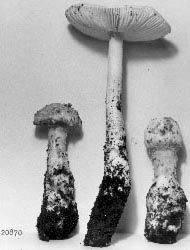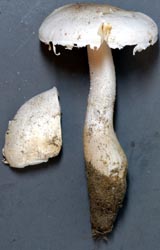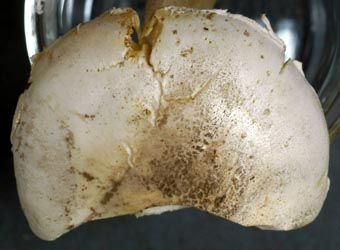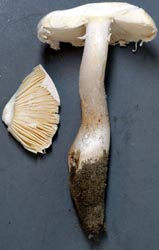|
[ Amanita cineroconia var. croceescens Bas ] Amanita cinereoconia G. F. Atk.
Technical description (t.b.d.) BRIEF DESCRIPTION: The cap of Amanita cinereoconia is 30 - 70 mm wide, from convex to expanding to flat or plano-convex, whitish to grayish, dry, with nonsulcate, appendiculate margin. The cap is covered with pale yellowish gray, brownish gray or pale umber, pulverulent-subflocculose, easily removable layer of volva tending to form small, more or less pulverulent wars, especially at the center. The gills are rather crowded to subdistant, free to slightly adnate, moderately broad, and white to pale cream. The short gills are rounded-truncate to attenuate. The stem is 50 - 100 x 4 - 9 mm, equal or tapering upward, solid, white, and usually exannulate. The volva is pulverulent-flocculose, rarely forming an inconspicuous, imperfect, cottony rim at the top of the bulb. Bas reports the spores to measure 8.5 - 11.5 (-12.5) × (4.5-) 5 - 6.5 µm and are elongate to cylindric (rarely ellipsoid, sometimes bean shaped) and amyloid. Clamps are absent at bases of basidia. Amanita cinereoconia is known from mixed (coniferous and deciduous) forests from the U.S. states of North Carolina, Tennessee, Virginia, and West Virginia according to Jenkins (1986). Bas (1969) based his stirps Cinereoconia on A. cinereoconia and included the following taxa in addition: A. griseofarinosa Hongo (described from Japan), A. lutescens Hongo (described from Japan), A. odorata Beeli (described from central Africa), A. pelioma Bas (described from the southeastern USA), and A. vestita Corner and Bas (described from SE Asia). -- R. E. Tulloss B&W photo by L. R. Hesler (Tennessee, with permission of Dr. R. H. Petersen, L. R. Hesler Herbarium, Univ. of Tenn., Knoxville) Amanita cinereoconia var. croceescens Bas
The following description is based on the original description by Bas (1969). The cap of Amanita cinereoconia var. croceescens is 60 - 100 mm wide, convex to plano-convex, with a broad, low umbo, yellowish-gray, dry, with a nonstriate and appendiculate, somewhat incurved margin. The volva is present as powdery-floccose remains that form small patches to a continuous layer over the margin, slightly darker than the cap color. The flesh is thin. The gills are subdistant, slightly connected to the stem, often irregular and growing into each other, rather narrow, up to 7 mm broad, intermixed with many narrower ones, whitish with a creamy tinge. The short gills are attenuate. The stem is 50 - 100 × 10 - 20 mm, usually subcylindrical or tapering slightly downward, sometimes conspicuously expanded at the top, solid, with or without a fragment of a ring. The bulb can be absent or somewhat turnip-like to somewhat spindle-shaped, usually rooting and is 25 - 40 × 15 - 25 mm. The stem is entirely covered with yellowish gray to gray-brown, soft flocculence, sometimes whitish at the top. The ring when present is apical, usually falls away, soft, pale yellowish gray, with fragments of the volva on the edge. The flesh is white, changing soon to deep bright orange when cut. The odor is distinctly like that of "chlorine." The spores measure (9-) 10 - 12 × (5.5-) 6 - 7.5 µm and are ellipsoid to elongate, sometimes broadly expanded at
one end and amyloid. Clamps are absent at bases of basidia.
This species was originally described from North Carolina (USA) and its tree associations are unknown. This variety differs from the type variety in its larger fruiting body, its proportionately broader spores, the irregular width of the gills, the tendency of adjacent gills to grow into each other (to anastomose), and the tendency of the flesh to turn orange when cut. After years of observing the "yellowing syndrome" in North American material in section Lepidella and taking into account the unusual irregular growth pattern of the gills in the present variety, RET suggests that this taxon may in fact simply consist of diseased specimens of A. cinereoconia. For more notes on the "yellowing syndrome" see A. subsolitaria (Murrill) Murrill. The illustration to the right shows a purple response to syringaldazine solution in ethanol in the bulb and lower stipe of a yellowing collection of A. cinereoconia. This response is positive for presence of lactase in the bulb. -- R. E. Tulloss and L. Possiel Photos (yellow staining specimen) by R. E. Tulloss (GSMNP, Tennessee).
[ go to top ] Last changed 30 September 2009. |








